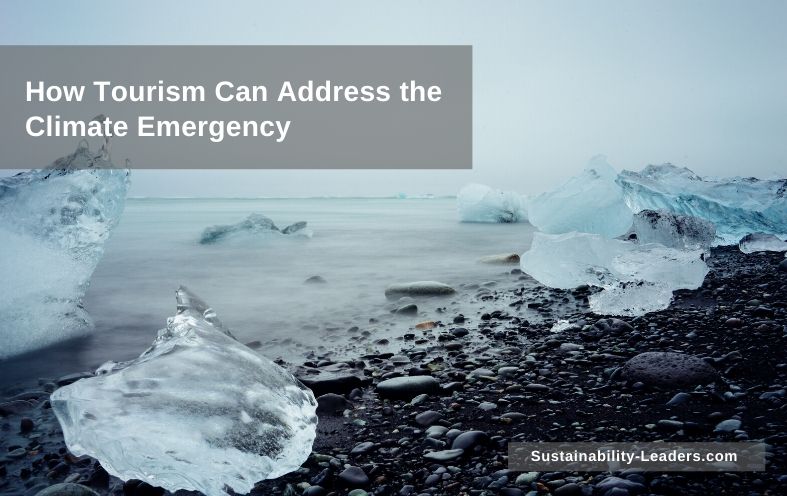
The coronavirus pandemic has turned travel upside-down almost overnight and is rightly receiving most of the attention right now. But there’s another crisis looming, which – at least – won’t catch us by surprise. Nevertheless, given the pace of damage that is already visible due to climate change, it is high time for the industry to prioritize sustainability in its strategies, and this period of forced stand-still might be the right moment to get started. But how?
Having looked at how the climate crisis affects tourism previously, this time we asked our panel of sustainable tourism specialists how businesses and destinations can address the climate emergency. Below the answers (highlighted respondents are available as consultants or speakers).
Our key takeaways:
- It’s best to follow certified and tested guidelines and approaches to achieve sustainability as part of climate resilience. The GSTC criteria in particular will make the task easier.
- Destinations should make domestic travel or visits from neighboring countries more lucrative.
- Following the example of Guyana, countries should develop conservation areas that can help absorb the CO2 generated through tourism, especially flights to the destination.
- Though the tourism industry has proven to be fairly resilient, unforeseen interruptions like the current pandemic should be seen by businesses and governments as a reminder to be more proactive and to consider sustainability as a top priority for resilience, especially also in the face of the climate crisis.
Brian Mullis
Interview | Speaker profile
Based on a recent article in The Guardian, it is estimated that the average European visitor generates a total of 2.79 tonnes of CO2 when visiting Guyana, including domestic and international air and ground travel.
The community of Rewa in the Rupununi region attracts 200 visitors per year, which equates to 558 tonnes of CO2 (assuming they all came from as far as London).
The community has created a conservation area for tourism which absorbs over 70,000 tonnes of CO2 (350 sq km x 200). This single community protected area alone sequesters more CO2 than the footprint of all of the travellers that visit Guyana’s hinterland.
For this reason, the Guyana Tourism Authority is working with the Ministry of Indigenous Peoples’ Affairs and Conservation International Guyana to scale up conservation tourism in collaboration with indigenous communities. The number of communities involved increased from four in 2018-2019 to ten in 2020.
 Jonathon Day
Jonathon Day
Interview | Speaker profile
Businesses and communities must commit to both mitigation – reducing greenhouse gases (GHG) – and adaptation. Adaptation means changing in response to changes brought on by climate change. Those changes can be gradual – a rising temperature year on year – or abrupt, like the impact of more intense hurricanes or flooding. Unfortunately, tourism has a pretty poor track record on preparing for disaster and that needs to change if we are to be sustainable.
 Kelly Bricker
Kelly Bricker
Interview | Speaker profile
The reality is, the entire supply chain must be addressed; how we are moving people, what efforts are being done towards conservation, how communities are directly included, and reinforcing this issue as a global community effort.
Practically, it begins with every entity doing its part to reduce emissions, conserve natural environments, and ensuring financial security that in part assists in the protection of natural and cultural assets people are inspired to travel to.

Kirsi Hyvaerinen
Interview | Speaker profile
Both businesses and places need to reset, questioning which values lead their action. Every response must have ecological balance and social justice in its core.
- Decarbonisation has started, but the way it is treated today, it will not be enough.
- The protection of wildlife, biodiversity, forests are one key – they cannot save themselves.
- For CO2 removal, we can use natural ways and new technologies.
The climate emergency, the current epidemic, and the resulting socio-economic crisis are global problems that can be solved only by global cooperation. To reach the Paris Agreement goals, we know what we must do. If the majority prefers living in denial, keeping economic growth as a measure of success, the biggest threat is in the human brain.
 Willy Legrand
Willy Legrand
Interview | Speaker profile
It is all about action. The technology is, to a large extent, available and getting cheaper. For example, as reported by the Fraunhofer Institute for Solar Energy Systems, in Germany the price for a “typical 10 to 100 kilowatt-peak (kWp) photovoltaic rooftop-system was around 14,000 €/kWp in 1990. At the end of 2018, such systems cost about 1,070 €/kWp on average”. This represents a net price regression of 92%.
Additionally, knowledge on the current state of the planet is not the realm of scientists’ office labs only anymore – from the summer heatwaves in Europe to the bushfires in Australia and the first heatwave in East Antarctica, climate emergency has reached everyone’s door. So, it is about action.
There are really two parts to that question on ‘how best to address’ climate emergency.
- There are industry professionals active in the industry today, making decisions on how the hotel industry is built and shaped for the next 5 to 30 years, how destinations are to be managed, preserved, and marketed.
- There is the next generation of hoteliers and destination managers– those currently at university – who will shape the industry for the next 50 years.
As a reminder, in order to keep pace with international efforts to limit global mean temperature (below 2°C and to pursue efforts to limit to 1.5°C) as set by the Paris Agreement, the hotel industry must consider partial decarbonisation by 2030 and close-to-complete decarbonisation by 2050. Therefore, both parties, those developing and operating hotels today and the future generation of hoteliers all have to play a role.
Since a large portion of our carbon emissions are linked to the way we design, develop, construct, refurbish, retrofit as well as heat, cool and ventilate our buildings; the larger picture involves our current supply of hotel properties as well as the construction pipeline.
The topic is relatively complicated in the hotel world due to the many parties involved in creating the ‘hotel’ experience. To make it short: the key issue here is to foster better coordination between investors, developers, brands, and operators so that sustainability has a chance to be enacted from the very first planning stages such as the initial feasibility. Some initiatives are already in place to promote such coordination.
Amine Ahlafi
Interview
It is important to address the climate crisis through:
- Building new hotels according to the Green Building Rating Systems (LEED: USA, BREEAM: UK, DGNB: Germany, CASBEE: Japan, Green STAR: Australia, GRIHA: India, HQE: France, Istidama: UAE) based on seven main domains contributing positively in tackling climate crisis issues like:
- energy efficiency and renewable energy
- water efficiency, environmentally preferable building materials and specifications
- waste reduction
- toxics reduction
- indoor air quality
- smart growth and sustainable development
- Engaging existing and new tourism accommodations in one of the tourism sustainability programs (Green Key, Green Globe Certified, GSTC for Destinations)
- Calculating the destination carbon footprint then offsetting its CO2 emissions through an NGO or a company tackling climate change impacts and translate this contribution through tangible actions.
- Destinations should encourage more local and regional tourism markets by strengthening incentives to attract local visitors and tourists from neighboring countries. That will widen the market and would set up an alternative to avoid the risks of international market effects.
Anna Spenceley
Interview
The World Economic Forum suggests that we can all reduce our carbon footprint through the way we travel, and by doing so, contribute towards SDG13 on climate action. These include actions that travellers can take, and also activities businesses and destinations can consider:
- Travel light by reducing consumption when we travel. This can include avoiding single-use plastic when we buy food and drink or use hotel toiletries and taking reusable cups and utensils on trips. An example of how a tourism business is addressing this – Hilton is tacking waste from soap in an alliance with Travel with Purpose.
- Travel with trust by looking for accommodations or destinations that use a certification program aligned with the Global Sustainable Tourism Council criteria (either the industry or destination criteria) and that uses renewable energy. The destination criteria are used by certification bodies such as Biosphere, EarthCheck, and the Green Destinations Standard to confirm that tourism destinations meet minimum standards. By choosing to travel to destinations that they certify, travellers can be assured that they are making good travel decisions. Examples of destinations that demonstrate this level of accountability towards sustainability include Costa Barcelona in Spain, Thompson Okanagan in British Columbia, and Toro Toro in Bolivia.
- Travel slowly and carefully considering our transport options, and making efforts to select options that have lower carbon emissions. This can include taking public transport, using hybrid or electric vehicles, or sailing boats (just like Greta does!). Destinations can help here, by providing more sustainable transport choices for visitors and residents to use.
Jeremy Sampson
Interview
Businesses and destinations need to work together to invest wisely and ensure the costs of managing climate risks are accounted for. Our report: Destinations at Risk: the Invisible Burden of Tourism with Cornell University and EplerWood International provides some thoughts around this, such as attracting funding from the impact investment community and offsetting schemes to drive green technology and infrastructure upgrades.
First off, however, it’s important to make the case for protecting destination assets such as natural, cultural, and historical sites by demonstrating their value and the investment needed to protect this. This could be a perfect opportunity for businesses to deliver their CSR programmes in a way that truly meets the needs of the destinations and protects the shared resources they both rely on.
Jonathan Tourtellot
Interview
One thing is to educate clients. Take Caribbean resorts, for example, which face numerous climate threats – reefs, sea levels, hurricanes, etc. No American tourist should leave a resort there without having been gently informed of climate impacts. Especially climate deniers.
The same goes for DMOs, which are genetically inclined to avoid anything ‘negative’ in their communications.
Kevin Teng
Interview
All businesses should be mitigating their own environmental footprint with adequate energy, water, and waste strategies. In addition, guest and staff communication is key and can be leveraged to drive business.
Masaru Takayama
Interview
It is certainly challenging. Promoting to the domestic market instead of the international market may be necessary. Taking account of that, the businesses now have more time to think and act on how to also tackle the CO2 emissions they generate from business as usual. Incorporate it into the corporate policy.
For destinations, it is often seen obligatory to create and implement climate change adaptations, but first, the destination needs to understand how much it is impacting the climate by calculating CO2 emissions. Then, it can find adequate carbon sink projects to work with.
Natalia Naranjo Ramos
Interview
Plans and strategies have to take into account two main aspects (that are supposed to be logical and basic, but we don’t take those into account and take them for granted): people and nature.
The economy in the original sense must be how people organize the way of living in a territory, taking into account nature and what we miscalled resources; and business would be the place where people interact to provide a service to the society/community and/or produce an item also useful for the society/community.
So, taking into account these ideas, plans, and strategies have to be discussed with stakeholders in all fundamental issues for life on earth (air, water, nourishment). Sustainability then has to be at the core of every business, as a transversal issue for people survival and conservation of local assets that provide tools for our survival. Then, the question would be, which actions have to be prioritized now to reduce our negative impact on our environment and society?
Rachel Dodds
Interview
The keyword is planning. Embedding climate mitigation and addressing all scope (1, 2 & 3) emissions into strategies and policies allows for action. Proactive, planned behaviour about what we already know is key. There are many low hanging fruits the industry and government have yet to pick.
Steve Noakes
Interview
We need to take a more proactive approach to climate change. We need to know more about the impact of climate change on the subtropical rainforests of Australia and what that means in terms of long-term infrastructure.
Binna Burra Lodge will be rebuilt in a way that takes into account the likely impacts of climate change. When we position, design, build and operate tourism infrastructure in these sorts of natural environments, we have to think about 50 or 100 years ahead and what changes climate impacts are going to have on the built infrastructure.
Our responsibility now is to have a vision that is crafted on the knowledge and the understanding of the climate as it will impact on the tropical and subtropical rainforest.
Vik Nair
Interview
Tourism businesses in any destination must be proactive in addressing the climate emergency as part of their sustainability strategies in their national development plan. Resilience is critical for the sustainability of the tourism industry in weathering natural disasters due to climate change.
Resilience has been defined as “the capacity of a system to absorb disturbance and reorganize while undergoing change so as to still retain essentially the same function, structure, identity, and feedbacks”. The essence of a resilient tourism destination is the ability of the destination (or the country) to regroup, re-evaluate, rebuild, and recover.
Hence, all destinations must put in place strategies for recovery due to the impact of climate change. These strategies must involve all the stakeholders, led by the government. In regions impacted by climate change, where the intensity and frequency of tropical cyclones and hurricanes have increased, a well laid out and tested plan should already be in place. Addressing climate emergencies must be a priority for countries that are already witnessing these changes.
As part of this strategy, it is important for these destinations to be aware of the market forces and the ability to harness them is vital during emergencies. Failing to do so will collapse the whole tourism industry. Further, stakeholder cohesion and associative working are critical as every stakeholder in the tourism sector (directly or indirectly) has separate roles and strengths, and only by deploying these in a coordinated fashion can resources be managed more equitably and sustainably.
Strong and consistent leadership expressed through clear vision and good management, either from individuals or institutions, is required to create structures that can resolve conflicts over resource use, drive forward change, and spark cohesiveness and market engagement amongst tourism stakeholders.
More about the sustainable tourism expert panel here – including previous sessions and answers to some of the most pressing issues linked to making tourism more sustainable.
Enjoyed reading about how tourism businesses and destinations can prepare for the climate crisis and move towards sustainability? Thanks for sharing!












